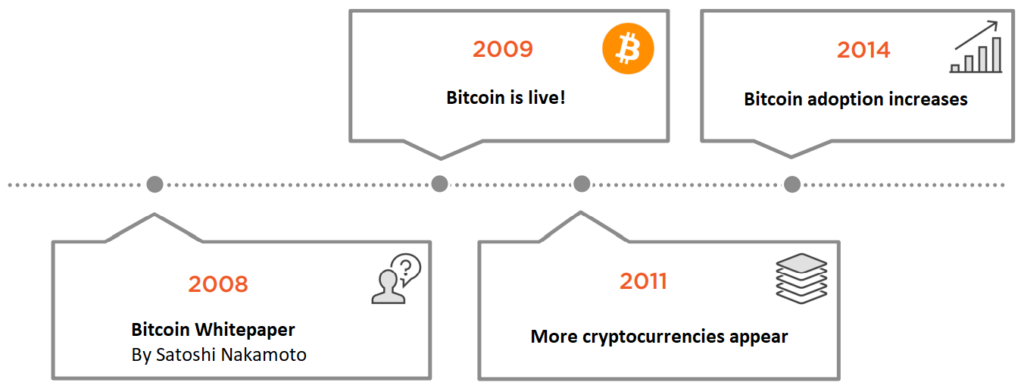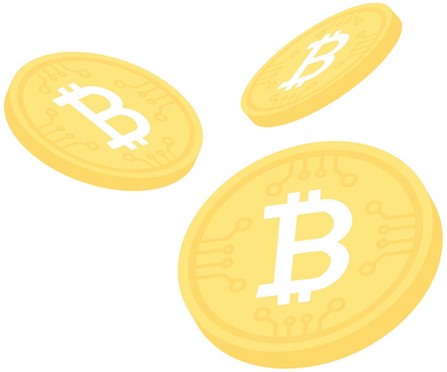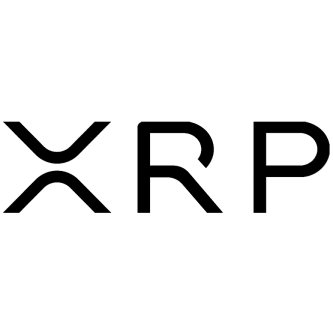Bitcoin is a digital currency that is not controlled by any institution or government. It enables electronic payments without the involvement of any third-party, by using a decentralised technology.
What is Bitcoin?
Bitcoin is the world’s most famous cryptocurrency, dating back from 2009. It uses a distributed ledger (the Bitcoin blockchain) as its backbone. The Bitcoin blockchain is a vast network of computers, also known as nodes, which all contain a copy of the distributed ledger that contains all Bitcoin transactions. It is called a distributed ledger because the ledger is replicated amongst all the nodes of the network.
The ledger is not owned by a central authority, like in the case of a traditional bank which would hold a proprietary ledger of all the transactions that its customers perform using their accounts in that bank.
To further learn about Bitcoin, we have organised this article in the following sections:
- History of Bitcoin
- Bitcoin technology details
- Why is Bitcoin valuable?
- What makes Bitcoin popular?
- What makes Bitcoin secure?
- Where to get Bitcoin?
- How to use Bitcoin?
- Is Bitcoin harmful to the environment?
- Conclusion
History of Bitcoin
Before Bitcoin, there had been numerous attempts at designing electronic cash systems that are independent of intermediaries such as banks and other financial institutions. However, Bitcoin was the first currency that actually solved the technical challenges that were hindering the realisation of such systems.
Bitcoin’s origins date back to 2008, in Satoshi Nakamoto’s famous white paper titled “Bitcoin: A Peer-to-Peer Electronic Cash System”. Bitcoin’s creator claimed that he had spent more than a year writing the initial code powering Bitcoin, after which the code became publicly available (or open-source in the tech jargon). Yes, anyone can see and contribute to the programme or computer code that implements Bitcoin. Needless to say, it’s quite an evolved programme, with the initial version having more than 31.000 lines of code! This code is run in the computers or nodes that form the Bitcoin blockchain and ultimately run the cryptocurrency.
Before his disappearance in 2011, Satoshi was very active with his contribution to Bitcoin, posting articles often and inviting other software developers to contribute to the Bitcoin code. In one of his articles, he claimed that his main drive behind the creation of Bitcoin was to challenge the conventional currencies and the institutions that have all the power in managing the course of those currencies. He wrote that although banks are entrusted with our money and its electronic transfer, they decide to lend it out in surges of credit bubbles while holding just a fraction of it in reserve. Bitcoin offers a different alternative: no single entity or authority owns Bitcoin, so no one can oversee or act and apply decisions and restrictions unilaterally.

Bitcoin technology details
However, central banks do more than just act as intermediaries in financial transactions. They have systems in place that make sure that the same money is not spent twice. So if Ann owned 50$ and spent them in a grocery store, she can’t spend that same money again. With cash, preventing double spending is easy, as the 50$ bill would no longer be owned by her and she wouldn’t be able to double spend. But with electronic transactions, where physical coins and bills aren’t involved, it gets more complicated. Banks help a lot in this, as their systems ensure that electronic money is not double spent either.
The way Bitcoin solves this problem without the involvement of banks or other institutions, is by using cryptography. All transactions are hashed and recorded in the blockchain (distributed ledger), which is shared among all the computer nodes that form the Bitcoin blockchain. The identity of the parties involved in the Bitcoin transactions is kept secret (privacy is one of the main goals of Bitcoin). However, all the blockchain nodes have information that a certain transaction has taken place, so the same Bitcoin cannot be spent twice.
Also, because the Bitcoin blockchain is public, anyone can get access to it and view all the transactions history. But note that although the transactions are stored publicly on the blockchain, personally identifiable information about the parties involved in those transactions is not. This makes Bitcoin transactions more transparent and traceable than cash transactions. In cash transactions, you can give your cash to another party and this information is not publicly available. If you’d be using Bitcoin for the same transaction instead, this transaction would be publicly visible in the Bitcoin blockchain. However, your identity as a Bitcoin sender or that of the Bitcoin receiver would not be revealed.
But in spite of all the hype and intricacy surrounding Bitcoin, at its most basic level, Bitcoin is simply a group of people maintaining a ledger.
Why is Bitcoin valuable?
So then, if Bitcoin is a decentralised system lacking central authority and governance, what then gives Bitcoin its worth, its value? The answer to that is trust. And if you were expecting a different answer and find it hard to give trust to a currency created by an anonymous person or group of people, just take a moment to think what in turn gives the US dollar, or Euro its value? The answer is the same, trust. Trust that those paper bills or coins that we have agreed to represent a dollar or a euro will be also valuable tomorrow. Trust that if you received them as a monthly salary today, you can still exchange them for something of value tomorrow or 10 years from now. In the case of dollars and euros, central banks and governments can decide to print new ones at any time.
Bitcoin on the other hand, was created in such a way that there is an upper limit of 21 million coins that can be generated, after which no more coins can be mined. Due to this limited supply, Bitcoin is considered as being even more valuable.

What makes Bitcoin so popular?
As already mentioned, Bitcoin is very different from other payment methods like debit or credit cards, or PayPal. For example, if you want to buy a book from some online seller, first you probably need to log in to their site, give away some personal information while doing so, and most importantly, provide your credit card information to complete the payment. Whereas if Bitcoin would be used instead, there would be no need to reveal personal information like address, email, credit card information. You could just send your bitcoin from a Bitcoin wallet.
One of the most important concepts in Bitcoin is privacy. In a modern world where personal and financial information is continuously stolen, one of the strongest precautions that can be taken is to limit the sharing of such information in the first place. When using Bitcoin, one doesn’t have to go through an institution like a bank that issues the credit card and then tracks all payments made via that credit card. This lets the bank know exactly how, at what time and where you spend your money.
Additionally, since Bitcoin uses a decentralised ledger distributed across thousands of computers across the globe, it is seen as more secure, as there is no single point of failure. Even if malicious hackers would try to tamper with Bitcoin transactions, the fact that those transactions are replicated across all nodes in the network, makes such attempts obvious and unsuccessful. So if a hacker or any malicious entity would try to change some transaction data in the ledger found in one computer, all the other ledgers replicated in the other computers would still have the original transaction data. Then by virtue of something known as consensus in blockchain, would render the non-complying ledger as erroneous.
And what are some further benefits of decentralisation? Well, although a centralised system would be much simpler to implement and maintain, the decentralised nature of Bitcoin is probably one of the main innovations behind it.
Any system is vulnerable to a single point of failure when it is of a centralised nature. Internal abuse, external attack, or censorship could all be causing these failures. Many currencies, for example, have experienced hyperinflation as governments issue money to pay bills. Just take the example of Zimbabwe, who began printing money in the year 2000 to fund government activities, which eventually led to hyperinflation. But even completely trustworthy corporations who operate as centralised systems, face the danger of being targeted by hackers or governments. Another issue with centralised systems is that they could be imposing several restrictions according to their own choice and business strategies that might benefit solely them.
| Bitcoin at a glance: | |
| Cryptocurrency ticker: | BTC |
| Creation date: | 2009 |
| Creator: | Satoshi Nakamoto |
| Consensus mechanism: | Proof-of-Work |
| Current price: | See live prices here |
| Maximum Supply: | 21.000.000 BTC |
| Hash algorithm used: | SHA-256 |
What makes Bitcoin secure?
We use the term cryptocurrency for Bitcoin because Bitcoin relies on cryptography in order to secure itself and its operations. Whenever user Ann sends a transaction to user John using Bitcoin, the transaction uses a digital signature that proves that Ann and only Ann authorised that transaction. A cryptographic digital signature has the same function as an actual written signature in a piece of cheque to prove authorisation.
But it is actually even superior in some aspects: a handwritten signature can be forged, whereas digital signatures are based on one specific transaction. Due to this, hackers cannot reuse a previous digital signature on a different transaction. These digital signatures are based on public/private key encryption, and it’s important to note that each Bitcoin account or address is essentially a public key. Associated with that public key is a private key (mathematically related to the public key) which essentially acts as a password that lets you generate digital signatures to authenticate transactions.
Where to get Bitcoin?
Next, let’s look at where to get Bitcoin. The easiest way to get Bitcoin is to buy some at a cryptocurrency exchange. There exist hundreds of cryptocurrency exchanges worldwide, and almost all of them offer Bitcoin, as well as a range of other cryptocurrencies. We have carefully written articles on our website that review the best exchanges to buy cryptocurrency from. They should be of great help to save you from the daunting task of reviewing and deciding which one of the hundreds of exchanges to actually use.
After choosing the exchange, the process of buying cryptocurrency on a high level is very simple. It includes the following steps: you need to sign up at the exchange’s website and provide some identification. After that, you simply go to a designated buy/sell page where you specify the amount that you want to buy and the payment method you will use. Depending on your location and the exchange chosen, you will be able to use a credit card, PayPal, or a wire transfer to pay for your cryptocurrency. After buying your Bitcoin, you should always transfer it to your cryptocurrency wallet.
A side note about privacy and exchanges. In many countries, institutions that work with money are obliged to abide to a number of laws aiming ti prevent fraud, terrorism financing and money laundering. Due to these laws, exchanges are required to know their customers, as well as monitor their transactions for any risky patterns of behaviour. So while sending and receiving Bitcoin can be done relatively anonymously, exchanging it with fiat currency usually requires revealing identity.
How to use Bitcoin?
Even-though bitcoin was originally designed as an electronic cash system to be used in peer-to-peer payments, many people see Bitcoin also as an investment. Buying and holding Bitcoin in the hope that its price will increase, thus generating profit for the holder, has become a very popular investment option.
There are also many people who use Bitcoin for regular trading, generating profit (or losses) from the difference in price.
When using Bitcoin as a payment method, a cryptocurrency wallet is required. The wallet keeps the private key of your Bitcoin, which in turn needs to be submitted when making a transaction. Today, many businesses, institutions and even governments accept Bitcoin as a means of payment. It is especially easy also for small businesses and e-commerce sites to accept Bitcoin as a payment method, and their number is ever-increasing: it is common to see Bitcoin listed as a payment option today alongside credit cards, PayPal, wire transfers etc.
Is Bitcoin harmful to the environment?
Bitcoin has been subject to criticism related to its environmental impact. Mining bitcoins is a process that requires high energy consumption, as the computers need substantial amounts of electricity to keep bitcoin mining operational.
However, there have recently been serious endeavours to substantially minimise the negative environmental effects caused by Bitcoin mining. The New York Times has published in September 2021 that Bitcoin’s use of renewable energy ranges from 40% to 75%. Nonetheless, Bitcoin continues to rank much higher in electricity demands when compared to other cryptocurrencies. Many people consider this as one of the main drawbacks of Bitcoin.
Conclusion
Bitcoin uses a decentralised, peer-to-peer technology to enable electronic payments without the involvement of third-parties. It was developed in 2009 by Satoshi Nakamoto, following a white paper he published in 2008.
As the first cryptocurrency ever developed, Bitcoin still holds the largest market share in the crypto market. Bitcoin has inspired a myriad of new coins to emerge. Its development also makes history in another aspect – the blockchain technology was actually first created to facilitate Bitcoin as an electronic payment system.
The Bitcoin blockchain is actually a vast network of computers, all maintaining a copy of the Bitcoin ledger which contains all the Bitcoin transactions ever made. Although the ledger is public, the identity of the parties involved in these transactions is kept secret.
Bitcoin has a limited supply. Once the limit of 21 million BTC is reached, no more Bitcoin will be mined. According to many, this fact adds additional value to the coin. Bitcoin uses the Proof-of-Work consensus mechanism, and the SHA-256 as its hashing algorithm.

